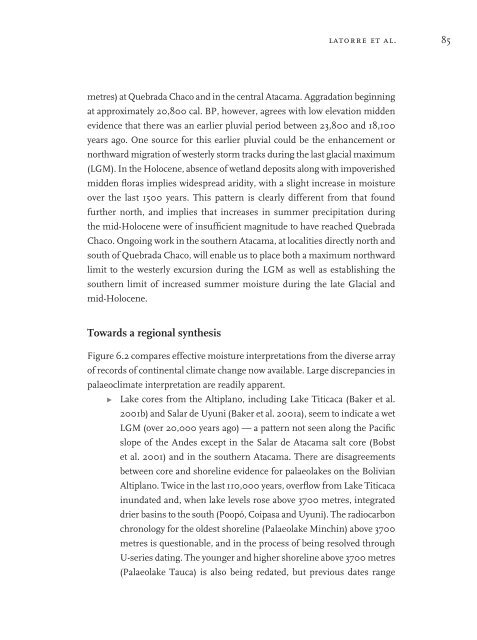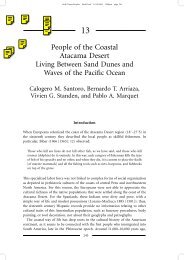Late Quaternary History of the Atacama Desert.
Late Quaternary History of the Atacama Desert.
Late Quaternary History of the Atacama Desert.
You also want an ePaper? Increase the reach of your titles
YUMPU automatically turns print PDFs into web optimized ePapers that Google loves.
latorre et al. 85metres) at Quebrada Chaco and in <strong>the</strong> central <strong>Atacama</strong>. Aggradation beginningat approximately 20,800 cal. BP, however, agrees with low elevation middenevidence that <strong>the</strong>re was an earlier pluvial period between 23,800 and 18,100years ago. One source for this earlier pluvial could be <strong>the</strong> enhancement ornorthward migration <strong>of</strong> westerly storm tracks during <strong>the</strong> last glacial maximum(LGM). In <strong>the</strong> Holocene, absence <strong>of</strong> wetland deposits along with impoverishedmidden floras implies widespread aridity, with a slight increase in moistureover <strong>the</strong> last 1500 years. This pattern is clearly different from that foundfur<strong>the</strong>r north, and implies that increases in summer precipitation during<strong>the</strong> mid-Holocene were <strong>of</strong> insufficient magnitude to have reached QuebradaChaco. Ongoing work in <strong>the</strong> sou<strong>the</strong>rn <strong>Atacama</strong>, at localities directly north andsouth <strong>of</strong> Quebrada Chaco, will enable us to place both a maximum northwardlimit to <strong>the</strong> westerly excursion during <strong>the</strong> LGM as well as establishing <strong>the</strong>sou<strong>the</strong>rn limit <strong>of</strong> increased summer moisture during <strong>the</strong> late Glacial andmid-Holocene.Towards a regional syn<strong>the</strong>sisFigure 6.2 compares effective moisture interpretations from <strong>the</strong> diverse array<strong>of</strong> records <strong>of</strong> continental climate change now available. Large discrepancies inpalaeoclimate interpretation are readily apparent.Ω Lake cores from <strong>the</strong> Altiplano, including Lake Titicaca (Baker et al.2001b) and Salar de Uyuni (Baker et al. 2001a), seem to indicate a wetLGM (over 20,000 years ago) — a pattern not seen along <strong>the</strong> Pacificslope <strong>of</strong> <strong>the</strong> Andes except in <strong>the</strong> Salar de <strong>Atacama</strong> salt core (Bobstet al. 2001) and in <strong>the</strong> sou<strong>the</strong>rn <strong>Atacama</strong>. There are disagreementsbetween core and shoreline evidence for palaeolakes on <strong>the</strong> BolivianAltiplano. Twice in <strong>the</strong> last 110,000 years, overflow from Lake Titicacainundated and, when lake levels rose above 3700 metres, integrateddrier basins to <strong>the</strong> south (Poopó, Coipasa and Uyuni). The radiocarbonchronology for <strong>the</strong> oldest shoreline (Palaeolake Minchin) above 3700metres is questionable, and in <strong>the</strong> process <strong>of</strong> being resolved throughU-series dating. The younger and higher shoreline above 3700 metres(Palaeolake Tauca) is also being redated, but previous dates range
















